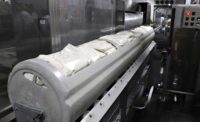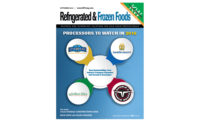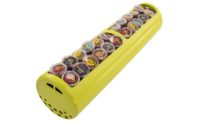When Quantum Foods filed Chapter 11 bankruptcy and closed its Bolingbrook, Ill., meat processing plant in 2014, it opened the toolbox, so to speak, for West Liberty Foods to expand its product line and customer base and bring back jobs lost.
“West Liberty Foods was very well-known in the quick-service restaurant side for its private label sliced lunch meats, deli counters and such,” says Ed Garrett, president and CEO of the West Liberty, Iowa-based meat processor. “But, Quantum Foods’ Bolingbrook location allowed us to enter into the next level of our customer base, which is the middle-tier casual sit-down restaurant, providing items we couldn’t offer before. It expanded our opportunity for items such as batter-breaded fried products, par-fried products, coatings, dustings and flavorings. We changed from a quick-service slice company to a food company that can offer many new products, many new proteins and knock on many doors we couldn’t before.”
Then, in 2016, West Liberty Foods opened Liberty Cold, a cold storage and supply chain business situated five miles away from the Bolingbrook plant.
Today, the 230,000-square-foot Bolingbrook facility is home to seven processing lines, 14 packaging lines, a culinary kitchen, an R&D and QA laboratory and state-of-the-art high-pressure processing (HPP) equipment, which helps produce more than 100 SKUs for retail and foodservice chains nationwide. That’s why West Liberty Foods was named Refrigerated & Frozen Foods’ 2017 Refrigerated Foods Processor of the Year. (To learn more about West Liberty Foods’ landfill-free certification and more, go to "West Liberty Foods—More than Just Protein Solutions."
“I don’t want to be a supplier to a fast food chain. I don’t want to be a supplier to a grocery store. I don’t want to be a supplier to a mid-tier fast-casual dining restaurant. I want to be a partner in their business,” adds Garrett.
The evolution of a food processing facility
Initially, the Quantum Foods site was a hand-cut steak operation. Today, it boasts the ability to produce fresh and frozen, raw and fully cooked, whole muscle and further processing and HPP foods.
At the time of Refrigerated & Frozen Foods’ visit, West Liberty Foods was manufacturing chicken wings.
Raw chicken conveys into a hopper, where the appropriate marinade is added. Then, product travels into a tumbler, before being brought onto an inspection table, where employees manually check for raw material defects such as blood spots and broken bones.
From the inspection table, the chicken conveys into the freezer. The entire process takes about an hour, according to Joe Cangelosi, plant manager.
In another room, West Liberty Foods was processing individual packaged meats such as beef tips on one line and poultry products on another for a combination of retail and foodservice customers. The process begins with operators trimming and sieving the meats before they’re marinated and packaged. The room houses three trim tables, where operators unwrap the meats, trim, portion, weigh and re-package.
Another room is dedicated to meatballs and protein snacks. One of the lines encompasses stuffing logs to a certain weight and diameter before entering a fryer. From there, product conveys into the oven, then exits through critical control point checks before entering the freezer. From the freezer, product is sliced and placed in 2-ounce packages.
“A lot of our processes are similar in that we have some sort of tumbling/grinding aspect to the business,” Cangelosi adds. “Each oven is comprised of two zones—one at the top and one at the bottom. Each zone is regulated differently, and we have different temperatures for each zone. We are constantly monitoring the temperatures, making sure the product is coming out of the oven as consistent as possible.”
The Bolingbrook site is also home to two different breading lines, as well as a par-fry breading line for chicken tenders, breaded patties and breaded chicken strips as well as a protein snack line and two ready-to-eat lines—one for meatballs and one for chicken wings and chicken strips—which are segregated and entail different personnel protective equipment and different food safety requirements, Cangelosi says. The Bolingbrook plant has the capacity to produce about an upward of 200,000 pounds of strips and meatballs a day.
In the ground beef patty room, product is ground together, then dumped into a hopper before entering a patty former. Once the patty is made, this same machine applies a sheet of paper between each one and shifts into packaging, where individual labels are manually applied.
The Bolingbrook manufacturing facility undergoes two audits every six months for ISO 14001 certification, and one audit a year for its NSF International-certified landfill-free verification, as well as annual BRC audits to maintain GFSI-certified status and customer-specific audits.
“Our process is comprised of both customer and certification audits, and we view every visit as an audit,” says Cangelosi. “Once the customer drives into our parking lot, the auditing process begins. They are coming here to see how we operate, how we work, and most importantly, how we are protecting consumer safety and company brand. This is why it’s important for us to be audit-ready every day.”
A cold storage facility’s role for the future
West Liberty Foods has been known as a slicing company, but needed to make that next step as a fully integrated supply chain food processing company, says Garrett.
That’s why Liberty Cold’s role is to create freight synergies with 3PL business and West Liberty freight, says Tim Cox, vice president of Liberty Cold.
“We want to build a scalable solution to deliver LTL freight across the nation for cooler and frozen products,” adds Cox. “We will do this by leveraging cross-dock technology to make it easy on businesses to move product through our warehouses in addition to our cold storage clients.”
The 173,000-square-foot, state-of-the-art facility was designed with food safety and security as top priority. The fully-fenced complex boasts more than 90 security cameras and 108 positions of blast freezing utilizing quick-freeze technology, with the capacity to handle more than 20,000 pallets of cold storage product.
The facility also offers HPP tolling, and is equipped with vertical dock levelers that allow the facility to control seals inside the building for enhanced load security. Liberty Cold also houses a USDA-compliant packing room and 47 trailer parking stalls.
“Our next phase is to build a business intelligence portal (early 2017) that allows customers to track their products and shipment throughout the supply chain,” says Cox. “Between a state-of-the-art facility and a portal to track their product, we strive to deliver a solution that delivers on food safety, food security and freight efficiencies.”
Supply chain for the future
West Liberty Foods’ supply chain operates at a high degree of flexibility and maintains high inventory turns.
“As a co-packer, the best way to maintain our base business is to achieve a high customer service level in terms of order fill,” says Brandon Achen, executive director of supply chain. “Our customers rely on us to change quickly to match their demand on short notice. We need to constantly evaluate ‘what if’ scenarios to make sure we are covered in different demand situations.”
Although the same supply chain team manages both the retail and foodservice categories, the differences lie in demand volatility and predictability.
“We have to be creative within the plant to build safety stock at work-in-progress steps when shelf life does not allow us to carry a buffer at the finished good level,” says Achen. “And, an increasing challenge with foodservice accounts is the amount of limited-time offers at restaurants. Some restaurants only want a certain protein on their menu for two months out of the year. This creates production scheduling and labor challenges within our facilities. We’ve had to adapt by shifting team members from lines that are running seasonally low items over to the limited-time offer lines that may only run several months out of the year. This keeps our labor balanced where the production volumes may not be.”
Yet, the main goal for 2017 is to go live with material requirements planning (MRP) software company-wide.
“MRP will move us from a relatively manual production scheduling process to a computer-generated process driven by actual demand and forecasts,” adds Achen.
West Liberty Foods is also looking to take time and miles off the product.
“We don’t need to have the product take 25 days from when it’s processed or harvested to when it gets into the finished box,” says Garrett. “If we can take time off the product, it only makes it safer and healthier to the end user.”
Go to http://bit.ly/1cMSPlA to check out the full photo gallery from the Bolingbrook, Ill., plant and Liberty Cold tours.


















